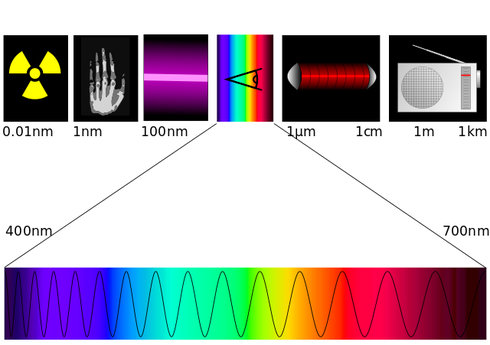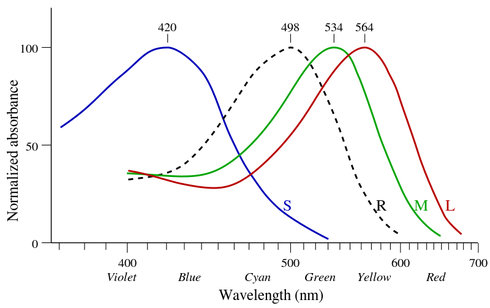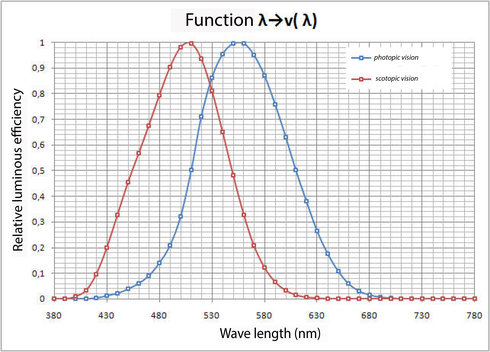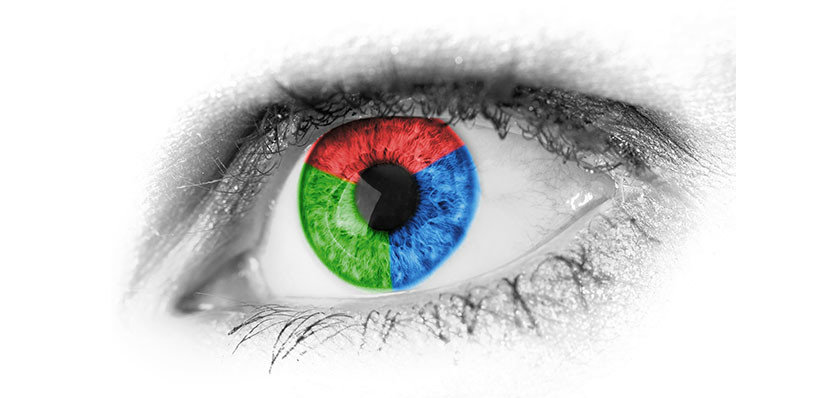Understanding colours through the eye
Download the PDFAccording to the physicists Huygens and Newton, light is both an electromagnetic wave and a particle, the photon! Of these two complementary theories that are still current today, the world of lighting uses the wavelength approach. This ball of energy moves at nearly 3000,000 km/s or 7.5 times round the earth in 1 second.
Colour of the visible spectrum
The colour of light is the synthesis of the electromagnetic waves perceived by the human eye. Just as with radio waves or cosmic rays, opticians talk about wavelength. However, only a tiny band of these waves is visible to the naked eye. From violet to red, the visible wavelengths are between 380 and 780 nanometres (nm).

Electromagnetic spectrum and visible spectrum – Illustration © Tatoute et Phrood, Wikipedia
The eye, cones and sticks
In the retina, there are two types of sensors:
- Cones are sensitive to high luminosities. There are 3 categories, those that are mainly sensitive to red, green and blue.
- Sticks are sensitive to low luminosities.

Absorbance curves per wavelength. (S), (M) and (L) correspond to blue, green and red cones, and (R) corresponds to sticks – Illustration : © After Bowmaker J.K. and Dartnall H.J.A, Wikipédia
The cones are used by human beings throughout the day. They allow us to have photopic vision. That is, luminance above 10 cd/m2.
The sticks are used by human beings at night and in the dark. They allow scotopic vision. In brief, when luminance is below 10-4 cd/m2. Here, there is no colour impression as only one type of cell reacts to the light stimulus, hence the saying “at night all cats are grey”.

Photopic and scotopic curves of human vision © Benjamin Monteil, Wikipédia
As our eyes respond differently depending on the quantity of light, our perception of a light source can vary with the ambient luminosity. In very dim lighting conditions, blue is more perceived than in bright light. Blue LEDs therefore seem more luminous at night. The flux values of lights are traditionally given under photopic conditions, except in the special case of Royal Blue. The reason: it is at one of the limits of the definition of luminous flux.
Primary colours in light
Colour is the interpretation of the stimulation of the three types of red, green and blue cones at the same time. It is thus the composition of our eye that explains the three primary colours of light. If you look at a screen very close-up, you will see small points of red, green and blue. This additive synthesis is presented in the CIE chromaticity diagram.
-
Download the PDF
- Published on 21 December 2015
- Category: Lighting techniques
- Tags : cone - eye - LEC - light - stick - vision - wave length


